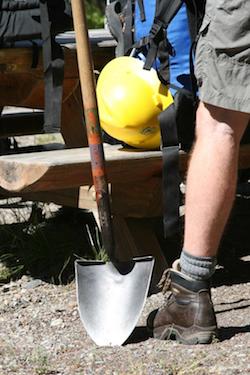SEJournal Online is the digital news magazine of the Society of Environmental Journalists. Learn more about SEJournal Online, including submission, subscription and advertising information.
TipSheet: Maintenance Backlog a Pothole on Road to Parks Consensus
To misquote a great American author: Everybody talks about the National Park maintenance backlog, but nobody does anything about it.
You will care about this if you ever visit a park: Broken screens in restrooms. Access roads like washboards. Washed-out bridges. Closed campgrounds. Trails that make you wish for another way.
Already this year, in Interior Department budget hearings, the parks maintenance backlog of $11.9 billion has been invoked — by people on both sides of several issues. But will the Washington talkfest open any campgrounds?
Let’s focus just for now on the National Park System. It has 59 parks, 415 sites in all (historical sites, monuments, battlefields, seashores, parkways, preserves and recreation areas.). It covers 84 million acres and receives 275 million visitors a year.
Land is still occasionally acquired for the National Park System. But not much, especially out west, where there is political resistance to adding land to parks.
There are also private landholdings within some parks, typically grandfathered in when the park was formed. The NPS picks these “inholdings” up when a landholder chooses to sell.
But for decades, NPS inholdings have been a flashpoint for a broader “Sagebrush Rebellion,” which resents federal land ownership and resists federal land acquisition.
Hot button issue for Sagebrush rebels
The NPS maintenance backlog has been a rallying point for this movement. Since at least the time of Interior Secretary James G. Watt (1981-83), Sagebrush rebels have argued that the federal government should spend its money to catch up on its maintenance backlog rather than to acquire new land.
 |
| Volunteers gather their gear for a wilderness trail maintenance project at Indian Henry's Hunting Ground, in Mount Rainier National Park in Washington State. PHOTO: National Park Service |
It is a good argument because the maintenance backlog is a real and serious thing. It is not, however, so good that Congress has actually chosen to spend enough money to clear the backlog.
Some in Congress are pushing to do just that — but the real onus lies with the House and Senate Appropriations Committees, particularly their Subcommittees on Interior, Environment and Related Agencies.
President Donald Trump proposed a 13 percent overall cut for the NPS — which may undermine the nominal increase he proposed for maintenance. Watch for the House subcommittee bill to drop (probably within weeks), and note whether the NPS gets more or less than Trump asked for.
Look also at the maintenance lines for the Bureau of Land Management, the Fish and Wildlife Service, and the U.S. Forest Service. Senators Mark Warner (D-Va.) and Rob Portman (R-Ohio) have introduced a bill aimed at taking on the NPS backlog. Rep. Mike Simpson (R-Idaho) has also introduced a bill.
In the current Congress, deferred maintenance has become a rallying cry for some who want to privatize the National Parks and other federal land. House Natural Resources Committee Chairman Rob Bishop (R-Utah) is one of those.
It is worth noting that more than a third of the backlog involves work on roads. That is something that could generate local jobs. Despite talk of “infrastructure” job programs from the current administration, there is no sign of the sort of park upgrade program the United States saw during the Great Depression.
Resources and perspectives
If you are not covering the national debate, the best entry to this story is your favorite local NPS unit. Zoom in to the unit(s) your audience cares about.
As a starting point for your recon, check out the NPS’ own latest report on its maintenance backlog. A general portal is here, a detailed list of the numbers for each NPS unit is here and an even more detailed inventory for each unit is here.
Once you focus on particular NPS units, go to the people who run them and ask for more detail, and explanations of what is actually going on. A fairly recent directory of the superintendents for each unit is here.
For perspective, you may want to contact some of the groups who advocate for the NPS. Chief among them are the National Parks Conservation Association and the National Park Foundation. For the latest NPS news and information, check out the website of National Parks Traveler, run by Kurt Repanshek, an independent journalist with a vast knowledge of the system.
Even better sources may be the people engaged with the parks at the local and regional levels. Many NPS units encourage volunteers to work with them, and many units have “friends” groups that have organized to support them. One directory of such groups is here. There is also an organized alliance of such friends groups.
Groups opposing land acquisition will be glad to talk about park maintenance. See, for example, a report entitled “Breaking the Backlog” from PERC, the Property and Environment Research Center.
* From the weekly news magazine SEJournal Online, Vol. 2, No. 27. Content from each new issue of SEJournal Online is available to the public via the SEJournal Online main page. Subscribe to the e-newsletter here. And see past issues of the SEJournal archived here.














 Advertisement
Advertisement 



